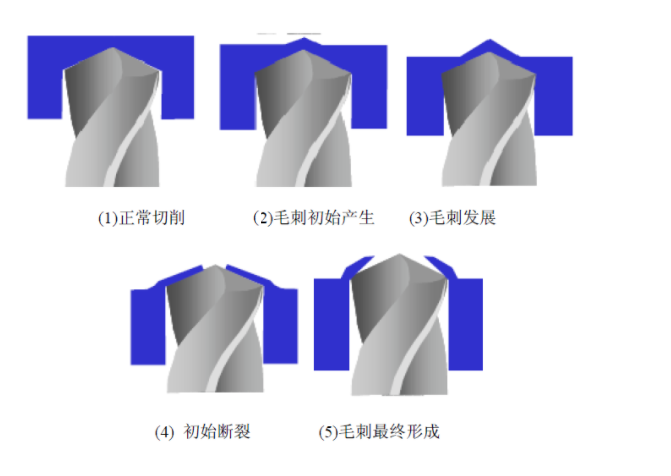
In the last few issues of dry goods sharing, the author added some basic information on the topic of cleanliness.
With the increasing cleanliness requirements of automotive powertrain products, more and more attention has been paid to the burr problem of machined parts. You can start to put more effort into researching methods of suppressing beforehand and cleaning up burrs afterward. Based on his own work experience, the author hopes to integrate and verify the problems encountered in the work and the cutting theory, and give readers some inspiration for solving problems.
In the previous chapters, the author introduced the basic theories such as the background of the burr problem, and also introduced the basic theory of the burr problem. In this issue, the author will introduce the content related to the drilling burr.
1. Definition of drilling burr
Drilling burrs usually refer to metal materials that appear at the inlet or outlet (through holes) and extend beyond the face of the inlet and outlet, as shown in the figure below.

The drilling process uses the rotation of the tool to perform the cutting process. When the drill bit enters and leaves the workpiece, it is accompanied by the constant change of the blade in and out. Therefore, the burr formation mechanism in drilling is more complicated.
When the drill bit enters the workpiece, the blade actually exits, so there is also a burr in the feed direction when cutting in. During through-hole drilling, due to the reduction of the support strength of the bottom of the workpiece, the bottom material undergoes strong plastic deformation, resulting in large-sized burrs. The drilling burr is significantly smaller than the drilling burr.
Compared with the exit burr, the entrance burr is relatively easy to solve. It can usually be solved by improving the tool centering performance, reducing the cutting parameters or even increasing the entrance chamfer. Therefore, we will strictly narrow the concept of drilling burr to "exit burr" below. .
2. Drilling burr formation
The burr formation process during drilling is roughly divided into 5 steps:

The first is the normal cutting process of the drill. During this process, the processing is carried out internally. Due to repeated cutting, there will be no burrs on the inner wall of the drill, as shown in the above figure (1).
As the processing continues, the material at the bottom of the drill bit is ejected due to the huge plastic deformation as the drill bit feeds, instead of being discharged with the helical groove of the drill bit, i.e. (2) and ( 3). With the further development and the fracture of the end material, some of the chips remain on the workpiece, and finally form the drilling burr, namely (4) and (5) in the above figure.
3. Drilling burr shape
According to the drilling of workpieces of different materials and different process parameters, three types of burrs with different shapes can be generated, namely uniform burrs, transient burrs and crown burrs, as shown in (a)(b)(c) in the following figure.

The uniform burr and transient burr are relatively small, and the height and thickness of the burr are evenly distributed along the edge of the hole; the crown burr is larger and distributed irregularly along the edge of the hole, which is one of the main reasons for affecting the machining accuracy of the workpiece.
4. Countermeasures for drilling burrs
The author has introduced solutions for drilling burrs in several articles, and interested readers can refer to
Three articles on "Cleanliness Issues, "Short Hole Clusters" in Through-Hole Drilling" and "Chip, Annoying Pixie".
For the rest of this article, refer to the relevant materials of cobalt collar tools, and focus on introducing the deburring tool to the reader.
Compared with the entrance burr, the exit burr appears on the other side of the workpiece away from the spindle. Unless the subsequent station will process the surface on which it is located, or the fixture is reversed, it is very important to rely on the tool to remove it. difficult.
Deburring tool, de-burring tool, this article refers to a tool that extends into the finished hole and removes the burr at the outlet end.
Its working principle is usually to first move the tool in a retracted state to the position that needs to be deburred, and then use the pressure of the coolant or the centrifugal force caused by the rotation of the tool itself to increase the diameter of the cutting edge of the tool and remove the burr.
As shown below:
In the first step, the tool moves (G00) to approach the workpiece

The second step is to quickly move the tool (G01) to the position of the intersecting hole; turn on the internal cooling and make the tool rotate to the recommended speed (Note: the internal cooling cannot be turned on before the front section of the deburring knife enters the hole, otherwise it will cause tool break)

The third step is to move the tool at the recommended feed rate until it passes the intersecting hole position; after passing the burr position, turn off the internal cooling, stop the spindle rotation, and quickly withdraw the tool from the hole. (Note: The internal cooling must be turned off before the deburring knife exits the hole, otherwise the tool will be broken)

Article summary
This article focuses on a tool for deburring the exit end of a through hole, and I hope you can be enlightened in solving the problem.